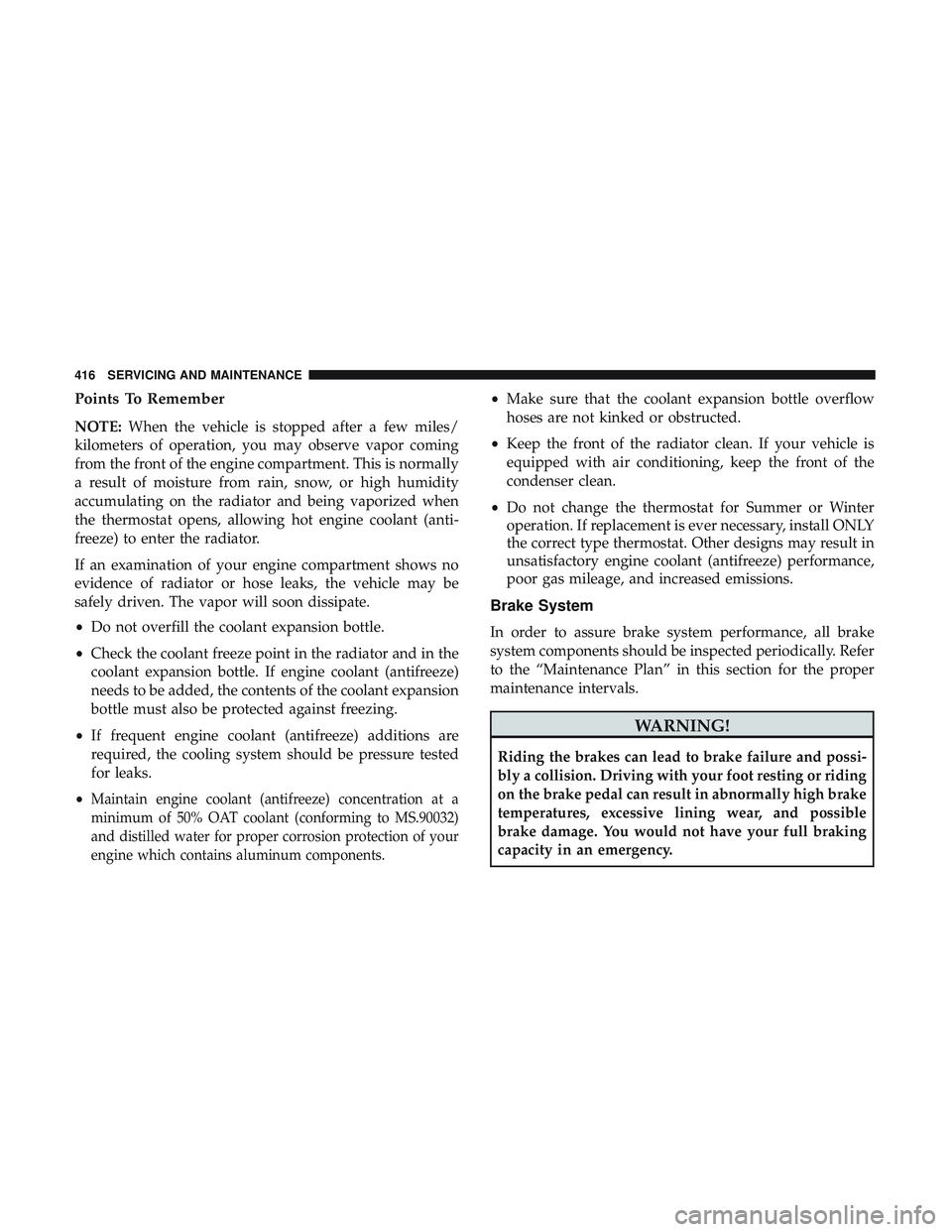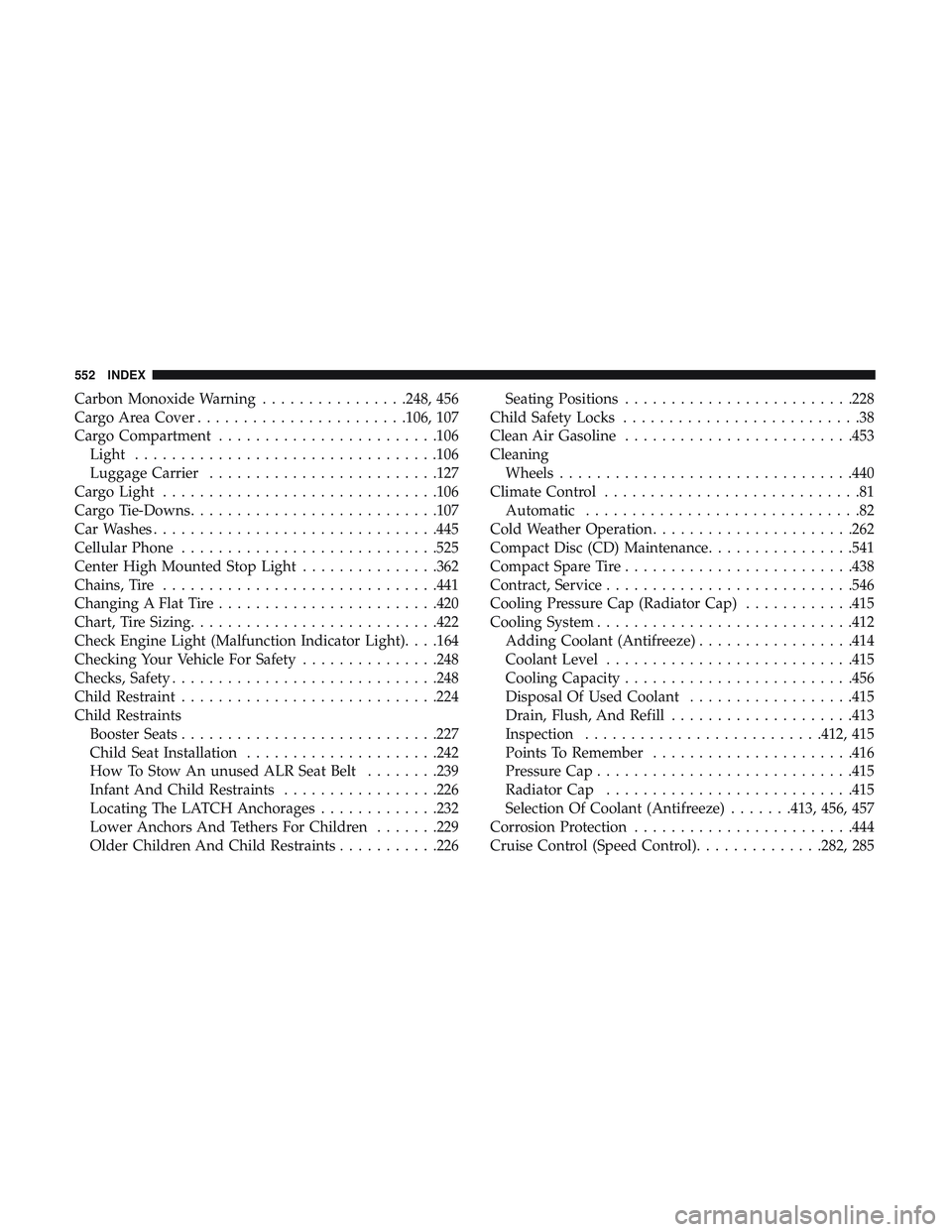coolant capacity DODGE DURANGO SRT 2018 Owners Manual
[x] Cancel search | Manufacturer: DODGE, Model Year: 2018, Model line: DURANGO SRT, Model: DODGE DURANGO SRT 2018Pages: 568, PDF Size: 6.54 MB
Page 418 of 568

Points To Remember
NOTE:When the vehicle is stopped after a few miles/
kilometers of operation, you may observe vapor coming
from the front of the engine compartment. This is normally
a result of moisture from rain, snow, or high humidity
accumulating on the radiator and being vaporized when
the thermostat opens, allowing hot engine coolant (anti-
freeze) to enter the radiator.
If an examination of your engine compartment shows no
evidence of radiator or hose leaks, the vehicle may be
safely driven. The vapor will soon dissipate.
• Do not overfill the coolant expansion bottle.
• Check the coolant freeze point in the radiator and in the
coolant expansion bottle. If engine coolant (antifreeze)
needs to be added, the contents of the coolant expansion
bottle must also be protected against freezing.
• If frequent engine coolant (antifreeze) additions are
required, the cooling system should be pressure tested
for leaks.
•
Maintain engine coolant (antifreeze) concentration at a
minimum of 50% OAT coolant (conforming to MS.90032)
and distilled water for proper corrosion protection of your
engine which contains aluminum components.
• Make sure that the coolant expansion bottle overflow
hoses are not kinked or obstructed.
• Keep the front of the radiator clean. If your vehicle is
equipped with air conditioning, keep the front of the
condenser clean.
• Do not change the thermostat for Summer or Winter
operation. If replacement is ever necessary, install ONLY
the correct type thermostat. Other designs may result in
unsatisfactory engine coolant (antifreeze) performance,
poor gas mileage, and increased emissions.
Brake System
In order to assure brake system performance, all brake
system components should be inspected periodically. Refer
to the “Maintenance Plan” in this section for the proper
maintenance intervals.
WARNING!
Riding the brakes can lead to brake failure and possi-
bly a collision. Driving with your foot resting or riding
on the brake pedal can result in abnormally high brake
temperatures, excessive lining wear, and possible
brake damage. You would not have your full braking
capacity in an emergency.
416 SERVICING AND MAINTENANCE
Page 554 of 568

Carbon Monoxide Warning................248, 456
Cargo Area Cover .......................106, 107
Cargo Compartment ........................106
Light .................................106
Luggage Carrier ........................ .127
Cargo Light ............................. .106
Cargo Tie-Downs .......................... .107
Car Washes ...............................445
Cellular Phone ............................525
Center High Mounted Stop Light ...............362
Chains, Tire ............................. .441
Changing A Flat Tire ........................420
Chart, Tire Sizing .......................... .422
Check Engine Light (Malfunction Indicator Light). . . .164
Checking Your Vehicle For Safety ...............248
Checks, Safety ............................ .248
Child Restraint ............................224
Child Restraints Booster Seats ............................227
Child Seat Installation .....................242
How To Stow An unused ALR Seat Belt ........239
Infant And Child Restraints .................226
Locating The LATCH Anchorages .............232
Lower Anchors And Tethers For Children .......229
Older Children And Child Restraints ...........226Seating Positions
........................ .228
Child Safety Locks ..........................38
Clean Air Gasoline ........................ .453
Cleaning Wheels ............................... .440
Climate Control ............................81
Automatic ..............................82
Cold Weather Operation ..................... .262
Compact Disc (CD) Maintenance ................541
Compact Spare Tire ........................ .438
Contract, Service .......................... .546
Cooling Pressure Cap (Radiator Cap) ............415
Cooling System............................412
Adding
Coolant (Antifreeze) .................414
Coolant Level .......................... .415
Cooling Capacity ........................ .456
Disposal Of Used Coolant ..................415
Drain, Flush, And Refill ....................413
Inspection ..........................412, 415
Points To Remember ..................... .416
Pressure Cap ............................415
Radiator Cap .......................... .415
Selection Of Coolant (Antifreeze) .......413, 456, 457
Corrosion Protection ........................444
Cruise Control (Speed Control) ..............282, 285
552 INDEX